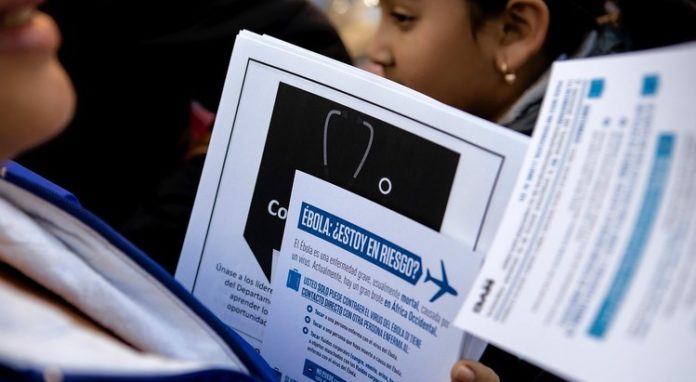
U.S. health officials laid out new guidelines Monday calling for voluntary isolation and monitoring of travelers exposed to Ebola, to counter a proliferation of divergent state rules over how to contain the outbreak.
The new guidance, issued by the Centers for Disease Control and Prevention, recommends that people at high risk of developing Ebola voluntarily isolate themselves from others and avoid public transportation for 21 days, but rejects the idea of mandatory quarantines.
The CDC guidance comes after the governors of New York and New Jersey announced mandatory 21-day quarantines for medical workers returning from three West African countries plagued by the worst Ebola outbreak in world history. Illinois and Maryland have also announced quarantines for health workers at high risk for getting the disease.
Previously the CDC has recommended screening of travelers from West Africa and monitoring of people for three weeks after they arrive in the United States. In the updated guidelines, the CDC broke down people into four categories based on risk status. Those at highest risk are anyone who’s had direct contact with an Ebola patient’s body fluids, including health care workers who suffer a needle-stick injury during a patient’s care.
For those people who are at highest risk and asymptomatic, the CDC recommended restrictions on commercial travel or attendance at public gatherings. The guidelines were not specific about where a person should stay, but officials said they meant home isolation if possible, or hospital isolation if necessary. For those with some risk, like anyone who lived in a household with an Ebola patient but didn’t have direct contact, travel restriction can be decided on a case-by-case basis, government officials said.
In announcing the guidance Monday, CDC Director Dr. Tom Frieden said he worried some of the announced state policies “have the effect of creating stigma or false impressions.”
Experts have repeatedly reassured the public that infected people can only spread the disease when they are actively displaying symptoms, like fever, vomiting and diarrhea. They have also warned lawmakers that that mandatory quarantines of those without symptoms are unnecessarily severe and will discourage health workers from going to West Africa to fight the epidemic, which could ultimately end up making the U.S. more vulnerable to the spread of Ebola.
Policy debates about Ebola patients escalated late last week, when Dr. Craig Spencer, a 33-year-old emergency room doctor, came down with Ebola symptoms several days after returning to New York City from medical aid work in Guinea. Before he developed symptoms, he rode the subway, went bowling and did other activities around town.
New York Mayor Bill de Blasio said Monday that Spencer’s condition remains serious but stable. No infection has been found in his fiancee but she remains under quarantine at the couple’s Harlem home. No one else has been reported as infected, and city health officials said New Yorkers should not be alarmed about contracting the disease.
More than 4,900 Ebola deaths and over 10,000 infections have been reported this year during the current epidemic, nearly all of them in Guinea, Liberia and Sierra Leone.
